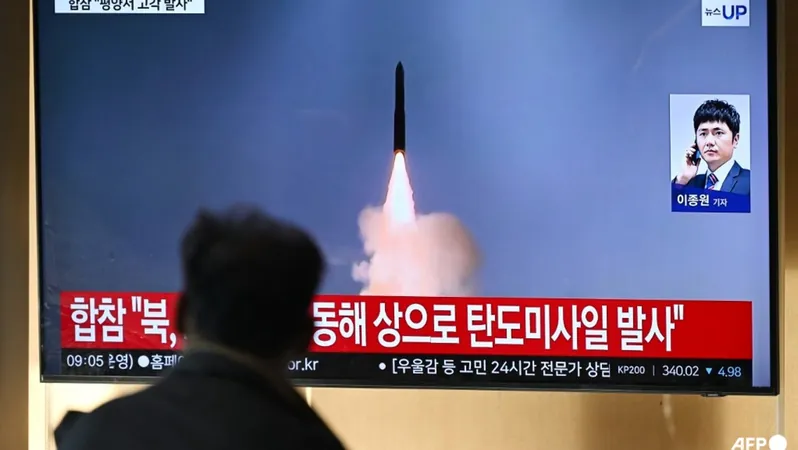
Breaking the Silence: How to Fight Osteoporosis and Empower Your Bones
2024-10-27
Author: Sarah
Imagine walking into a room packed with women, only to find that one in two of them will suffer a fracture due to osteoporosis as they age. These alarming statistics from the Royal Osteoporosis Society highlight the urgent need for awareness and action surrounding this silent disease. In the UK alone, approximately one in two women over 50 will fracture a bone because of osteoporosis, with a staggering one-third of those suffering a hip fracture facing death within a year. But the truth is, these devastating outcomes can be prevented.
Osteoporosis often goes unnoticed until it’s too late. According to Dr. Vonda Wright, a leading American orthopaedic surgeon, 'Your bones are silent until they break. And then they scream.' When hormonal changes hit during menopause, women experience a significant decrease in bone density—between 10% to 20%. This steep decline can lead to fragile bones that are as brittle as honeycombed candy, making even minor falls perilous.
We need to pay attention to the stories of those already affected. Narelle Chidwick from Henley was shocked to discover her osteoporosis diagnosis during a routine NHS bone scan that followed an injury sustained while skiing. 'I didn't see it coming,' she lamented, recalling her dedication to exercising and maintaining a healthy diet prior to her diagnosis. Now determined to combat her condition, she advocates for awareness and action against osteoporosis.
So, how can women proactively protect themselves against fractures? Dr. Olivia Hum, a GP and menopause specialist, emphasizes three key strategies: engaging in weight-bearing and muscle-building exercises, consuming calcium and vitamin D-rich foods, and considering hormone replacement therapy (HRT) to slow bone loss and foster new growth.
Despite the potential benefits of HRT for women, a shocking gap remains in healthcare when it comes to preventive measures. NHS data reveals that out of over 356,000 women treated for osteoporosis-related fractures, only a mere 169 were offered HRT afterward. This lack of attention towards younger women at risk—due to low body mass, family history of osteoporosis, or past eating disorders—is detrimental.
Research supports the efficacy of HRT; studies have shown it can increase bone density by an average of 7% over two years and reduce spinal fractures by a third. Growing awareness and acceptance around HRT is crucial, especially as newer transdermal preparations have proven safer with less risk of complications.
But what about lifestyle changes? Dr. Gabrielle Lyon, an American expert in muscle health, notes that maintaining muscle mass is key. Muscle loss, known as sarcopenia, can begin early during perimenopause, which is when many women need to start prioritizing strength-building exercises.
Rather than settling for the outdated notions of fitness that de-emphasize strength in women, Dr. Wright encourages women to lift weights, noting that exercises like deadlifts and squats are instrumental in combating bone loss. Following her lead, Chidwick turned to a personal trainer to curate a strength and impact training program tailored to her needs, rejecting the mediocre advice typically offered by healthcare professionals.
The evidence is clear: high-intensity impact training can significantly improve bone density, and studies have demonstrated measurable benefits in postmenopausal women who engage in rigorous exercise routines. Yet the lingering stigma around women's strength remains a barrier, as many still cling to outdated ideals of femininity that celebrate skinniness over strength.
Dr. Radhika Vohra, a GP, believes that educational initiatives are needed to counter these ideas and to promote preventive care before issues arise. Ideally, screenings should begin in women’s 40s, as many health checks focus solely on chronic conditions rather than discussing osteoporosis or menopause.
This gap becomes even more apparent in women from diverse ethnic backgrounds. Research indicates that women of South Asian descent are at risk for osteoporosis comparable to their Caucasian counterparts, yet only 6% are currently on HRT. We urgently need to address these disparities and increase awareness about osteoporosis within underserved communities.
The NHS spends a staggering £4.6 billion annually due to osteoporosis-related issues, and though public understanding is improving, many still lack basic knowledge about the condition. We cannot ignore the necessity for widespread educational campaigns that demystify osteoporosis and empower women to take control of their health.
This isn’t just about fractures; it's a fight against the silent epidemic of osteoporosis. We need to act now—earlier screenings, robust health programs, and a shift in how society views women’s strength can change the game. As Chidwick puts it, 'What if I’d been given a Dexa scan when I went into early menopause? We can’t just put a Band-Aid on afterwards.' The message is clear: proactive measures today can save lives tomorrow.
In the words of Kate Muir, author of Everything You Need to Know About the Menopause, it’s time to create an empowered dialogue surrounding menopause and osteoporosis. Let’s start prioritizing women’s bone health now, before it’s too late.


 Brasil (PT)
Brasil (PT)
 Canada (EN)
Canada (EN)
 Chile (ES)
Chile (ES)
 España (ES)
España (ES)
 France (FR)
France (FR)
 Hong Kong (EN)
Hong Kong (EN)
 Italia (IT)
Italia (IT)
 日本 (JA)
日本 (JA)
 Magyarország (HU)
Magyarország (HU)
 Norge (NO)
Norge (NO)
 Polska (PL)
Polska (PL)
 Schweiz (DE)
Schweiz (DE)
 Singapore (EN)
Singapore (EN)
 Sverige (SV)
Sverige (SV)
 Suomi (FI)
Suomi (FI)
 Türkiye (TR)
Türkiye (TR)